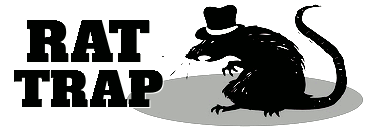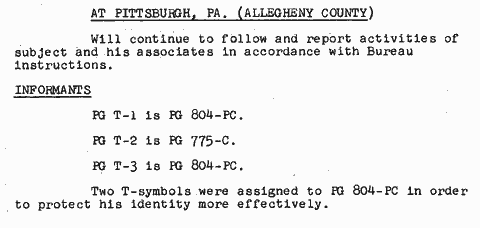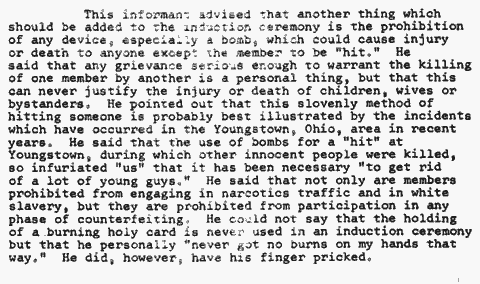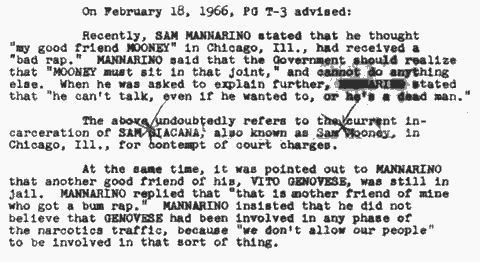"...There ain't the same kind of discipline there used to be 30 years ago."
- Sam Mannarino

Sam
Mannarino
Samuel Mannarino was a prominent La Cosa Nostra figure in Western Pennsylvania for decades until his death in 1967. Along with his brother, Gabriel "Kelly" Mannarino, he controlled gambling and related activities in New Kensington and the northern part of Westmoreland County for the Pittsburgh Crime Family. [1] The Mannarino brothers also had an interest in the Sans Souci casino in Cuba in the 1950s. [2] Samuel Mannarino was forced into retirement by the organization in 1958, after one too may run-ins with law enforcement and declining health.
Samuel Mannarino met with agents of the Federal Bureau of Investigation for informal chats throughout the mid-1960s. The FBI assigned him the informant symbol number, "PG 804-PC." [3]
Mannarino seems to have engaged in conversation with federal agents mostly out of boredom and a slight sense of disappointment over the abrupt end to his criminal life. His revelations to the agents never went very far, but he did shed light on his criminal past and the history of the Pittsburgh Crime Family to a degree that probably would have gotten him in trouble with his superiors if it had leaked out.
He never tried to jam up any of his former criminal associates and he never revealed anything that would put him in the category of a full-fledged informant.
'Retired racketeer'
The information provided in this FBI report was supplied by three sources. The first source was identified as a member of the Pittsburgh Crime Family. [40] The third source was identified as a "retired racketeer who is a close personal friend of Samuel Mannarino." The first and third source were the same informant (symbol number "PG-804") referred to separately to protect his anonymity. Mannarino was repeatedly described as a "retired racketeer" in numerous FBI reports.
Early days
Samuel Mannarino told federal agents that he got his big break in the Pittsburgh underworld in his early 20s. He was selected to be the chauffeur for gangster Giovanni Bazzano. Bazzano was the boss of the Pittsburgh Crime Family for a short time after the murder of former leader Guiseppe Siragusa in September 1931.

Bazzano
Mannarino drove Bazzano around Pittsburgh, running errands and meeting other gangsters. Mannarino recalled all of Bazzano's old associates had handlebar moustaches. [4] He said Bazzano was "very fond" of him and helped his criminal career. [5]
Giovanni Bazzano's tenure as boss lasted less than a year. It ended when he was killed for his part in the unsanctioned murder of his criminal rivals. According to Mannarino, Bazzano was summoned to New York City and "was killed by about 80 icepick stabs." [6] He told the FBI that Bazzano "had it coming" and said he "felt no pity for him." He said Bazzano was buried in the local cemetery.
Mannarino said he knew very little about Stefano Monastero and Giuseppe Siragusa, the two Pittsburgh bosses before Giovanni Bazzano. He had heard stories about them but said they were "before my time." The only thing he could recall was Monastero was shot coming out of the hospital while Siragusa was killed in his bathroom.
Mannarino explained to the FBI how he helped the Pittsburgh Crime Family muscle into gambling clubs in the 1920s and 1930s. [7] Mannarino and his associate, Joseph Rosa, would use intimidation and violence to force owners to take them on as partners. If an owner of a gambling club resisted, Mannarino said he had his property damaged or got his "head broken." Mannarino and Rosa would usually pay the owner a "fair price" for half ownership of his business. Other times, they would pay nothing.
Mannarino recalled how he convinced the owners of one gambling club to cooperate by lining them up against the wall at gunpoint and threatening to kill them in the style of the "St. Valentine's Day Massacre." Mannarino said, "the two operators broke completely and pleaded to be allowed to share their gambling profits."
Mannarino said that when "Jewish gamblers" saw him walking down the street, "they all disappeared as though hiding from the plague." [8] He admitted that he took pleasure killing people when he was younger. [9] He told federal agents, "I used to enjoy it." [10]
Induction ceremony
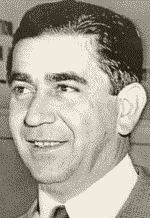
Gabriel
Mannarino
Samuel Mannarino admitted to the FBI that he was a member of "La Cosa Nostra or whatever you want [to call it]." [11] Federal agents asked him if Pittsburgh Crime Family boss John LaRocca had sponsored him and his brother into the organization, and he grinned and replied, "Who else?" [12]
Mannarino shared details about his induction ceremony. At the time he divulged this information only a handful of other LCN members had ever talked about their induction ceremonies with federal law enforcement. He told agents that his finger was pricked during the ceremony but no holy card was used or lit on fire. Mannarino couldn't say if holy cards were used in other induction ceremonies, but he personally "never got no burns on my hands that way." [13]
He said the last induction ceremony in Pittsburgh took place "a long time ago - too long, maybe." [14]
Mannarino told federal agents about the "honor" of being a member of La Cosa Nostra and spelled out the membership rules for them. He said a member couldn't kill another member without permission. A member could only kill another member if his honor was affronted or in self defense. He could only kill him in the heat of the moment. If he decided he wanted to kill the member after the fact, he needed the permission of the boss. He couldn't kill someone for financial gain or to attain power.
Mannarino advised federal agents that LCN members were forbidden from using bombs or handling narcotics, prostitution and counterfeiting. He said a recent bombing in Youngstown, Ohio, that killed mobster Charles Cavallaro and his eleven-year-old son had "infuriated" him. He said nothing could ever justify the injuring or killing of women, children or innocent bystanders.
'PG 804-PC'
Informant "PG 804-PC" and Mannarino supplied roughly the same information about the unsanctioned Youngstown bombing that killed Charles Cavallaro and the subsequent mob killing of the bombers. [39]
He said the bombing had forced the organization "to get rid of a lot of young guys" in the Youngstown underworld. Mannarino said there were "about two more guys to go" before the situation would be cleaned up. [15]
Mannarino refused to identify any member of the Pittsburgh Crime Family besides John LaRocca, his brother or himself. However, he did say there were about thirty members in Western Pennsylvania but only six were active. [16] When asked to identify any of them by name, FBI agents indicated that "no amount of persuasion could get him to identify [LCN members in Pittsburgh]." [17]
Mannarino said John Bazzano, the son of Giovanni Bazzano, was married to the daughter of Antonio Ripepi. The FBI knew from other sources that Ripepi was a prominent LCN member. Mannarino told the FBI that despite being the son of a former boss, Bazzano wasn't a member, "He'll always just be Johnny." [18]
Samuel Mannarino drew a line at incriminating himself or any of his criminal associates. Federal agents tried a number of times to get Mannarino to answer questions about his brother's criminal activities - Kelly Mannarino was running LCN operations in New Kensington at the time - but he just ignored them. Mannarino had been sidelined by his brother and the organization years earlier, yet he refused to throw any of them under the bus.
John LaRocca
Mannarino told federal agents that he had a great deal of respect for John LaRocca. He said everyone liked the longtime boss of the Pittsburgh Crime Family. He described him as a "peace-loving homebody." He said LaRocca was never seen in public with other mobsters and never went to nightclubs or mob hangouts.

LaRocca
Mannarino said John LaRocca brought a new mindset to the Pittsburgh underworld when he came on the scene in 1942. (Mannarino never said when LaRocca officially took over as boss. It's generally accepted that Frank Amato was the LCN boss in Western Pennsylvania from the late 1930s until the 1950s.) Before LaRocca, LCN members would just sit back and count their money, he said. They relied on "musclemen" and "stooges" to operate their gambling clubs. LaRocca forced LCN members to become "workers" and become actively "engaged in the administration of the numerous gambling establishments themselves." [19]
According to Mannarino, LaRocca had conflict-resolution skills that were ahead of his time. He preferred negotiation and compromise over murder and violence. He tried to resolve grievances without bloodshed. Mannarino said there were fewer mob killings in Pittsburgh than in other cities because of this attitude. LaRocca would use violence only as a last resort.
Mannarino gave the example of John Costello, an old-time bootlegger and gambler from Western Pennsylvania. Costello used to intimidate people by telling them he was a member of La Cosa Nostra and that he was a close associate of Mannarino and LaRocca. Mannarino was offended by Costello and wanted to kill him. LaRocca said killing him wasn't worth the risk. LaRocca said that if Costello ever did anything to impact their business, he would kill him. Costello ended up dying of natural causes not long afterwards, and Mannarino never had to worry about him again.
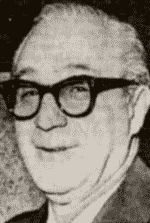
Al Zeid
Mannarino eventually adopted LaRocca's approach for himself. He told federal agents about a building contractor who had recently cheated him out of money. His brother, Kelly, wanted to kill the man or break his legs. Mannarino decided to give the swindler a pass because the amount stolen was small, and it wasn't worth the risk. He said Kelly was disgusted with him that he would take that attitude. [20]
Mannarino told federal agents he had no involvement in the 1965 murder of Al Zeid, a former criminal associate. He said that he was in prison at the time of the murder. (Mannarino served a prison sentence between 1964 and 1965. Zeid was found dead at a Donegal Township, Pennsylvania, farm on June 25, 1965.) He denied rumors that he had ordered two "young punks" to kill Zeid. Mannarino told federal agents that he wouldn't do such a thing because he wouldn't want to end up in the electric chair. Mannarino added that he had done his "share of killing in the past." If Zeid needed to be killed, he would have done it himself or with a close friend. [21]
He said the Pittsburgh Crime Family didn't kill people like it "used to do in the 1930s." The mob hadn't killed anyone in thirty years until the Zeid killing. Mannarino told the FBI that mobsters in Chicago and Cleveland weren't "as civilized as we are … they still act like animals." Pittsburgh realized "there are better ways of handling things than by killing." [22]
Random thoughts
Samuel Mannarino called Albert Anastasia an "animal." He said the former boss of the Gambino Crime Family should have been killed years earlier. He told the FBI that Anastasia had killed more people than "you got hairs on your head." [23]
Mannarino told federal agents that he knew Chicago Outfit boss Sam Giancana. He said Giancana had received a "bad rap" when he was sent to jail on contempt charges in 1965. Mannarino explained that "my good friend Mooney" had no choice but to refuse to answer questions put to him by authorities. He said Giancana "can't talk, even if he wanted to, or he's a dead man."
Vito Genovese was "another friend of mine who got a bum rap." Genovese was imprisoned for narcotics trafficking in 1959, largely on the testimony of a low-level drug dealer. Mannarino said the charges against Genovese were false because "we don't allow our people" to sell narcotics. [24]
Mannarino told federal agents that he knew hoodlum Harold Konigsberg. The New Jersey mobster had recently turned state's evidence. He was Jewish but he worked mostly with the Italian mob. Konigsberg had told law enforcement that he buried murder victims in a mob cemetery in New Jersey. Mannarino said the Italian mob had similar burial spots all over the country. He said "one of our biggest mistakes is telling too much to the Jewish guys we have to work with." [25]
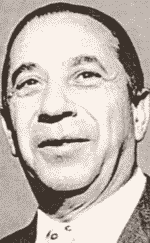
Sam
Mannarino
Mannarino operated in New Kensington, Pennsylvania, thirty minutes northeast of Pittsburgh. He told the FBI that he didn't bother to operate in Pittsburgh because it was too costly. He said his organization could easily take over the gambling rackets there but corrupt politicians and police officials expected payoffs of 30 percent, making the effort unprofitable. [26]
Mannarino lamented the new breed of mobsters coming up within the organization. [27] He felt prospective members had "very little proper training ... [and] there ain't the same kind of discipline there used to be 30 years ago." According to Mannarino, misconduct that in the past would have resulted in the individual's death, like stealing from the organization, now goes unpunished. [28]
Mannarino had nothing good to say about Thomas "Sonny" Ciancutti, one his brother's close associates. "I wouldn't be seen walking across the street with that punk." He said Sonny Ciancutti and John Fontana, another criminal associate, were not members but they might as well be. They have to live the same and obey all the rules. Mannarino said Ciancutti would never have been considered for membership in the old days. "He would have been made a member of the cemetery 30 years ago." [29]
Mannarino told the FBI that he had recently received $350,000 for property he owned that had been appropriated by the city for redevelopment. He considered using the proceeds to build a small shopping mall and apartments but decided against it. Instead, he said he was going to give the money to his daughter for her financial wellbeing. [30]
Mannarino owned land in Las Vegas that he was holding onto for speculative purposes. He said he could sell it for a huge profit if he wanted to.
He told the FBI he went hunting with two friends in British Columbia in 1965. He liked to hunt grizzly bears. On their return home, the group decided to visit Las Vegas. Mannarino was afraid the casinos would bar him entry because he was a notorious hoodlum. He told federal agents that he was relieved to discover he wasn't on the list of unwelcome gamblers. [31]
Mannarino told federal agents in November 1966 that he had been recently refused entry into Canada. He had gone there again to hunt. He was convinced that he had been deported due to an official letter from a U.S. government agency outlining his criminal record. [32]
Health issues
Samuel Mannarino had a history of abdominal problems. He told federal agents that he had undergone surgery in 1958 that left him with a 14-inch scar on his torso.
He credited a year-long sentence at the federal penitentiary in Lewisburg with restoring his health. He said the "regular hours and food" had improved his condition and left him feeling the best he had in years. [33]
His good health didn't last long. In July, 1966, Mannarino was admitted to the hospital with severe abdominal pain. The doctor's ended up removing five inches of his intestine. Mannarino told federal agents that he was happy that the surgeon was able to make the incision along the original scar line, limiting additional scaring. [34]
Mannarino told the FBI he lived a simple life. He didn't have the energy he had in his younger days. He said he "was just getting too old." [35] He spent his day at his office tending to his legitimate businesses or at the family-style restaurant he owned. Mannarino said hoodlums weren't welcome at his restaurant. He told agents that most evenings he stayed home and watched television. [36] Despite lingering bitterness about the way he was shunted aside by John LaRocca, Mannarino kept his commitment to the Pittsburgh Crime Family to the end: "They know if they should ever need me for anything. I'll be there." [37]
By today's measure, Mannarino's comments are unremarkable. He never betrayed his friends or compromised the organization. And he never wrote his memoirs or gave interviews to the press like many LCN members that followed him. But there was a time in the Italian-American underworld when a mobster would go to jail before he would talk to law enforcement or admit that he was a member of La Cosa Nostra.
Samuel Mannarino died of cancer at age 61 on June 6, 1967. [38]
Notes
1 FBI, Samuel Mannarino, Pittsburgh Office, Feb. 18, 1966, NARA Record No. 124-10284-10051.
2 The Mannarinos were associated with Nu-Ken Novelty, a distributor of slot machines and pinball machines. Their slot machines became popular with Cuban gamblers. During the Cuban Revolution, the brothers were suspected of running guns to the forces of Fidel Castro.
3 Most of the conversations were with SA Thomas G. Forsyth, III, from the FBI's Pittsburgh office. Sometimes the FBI documents used Mannarino's true name, but other times only the informant symbol number would be used.
4 FBI, Samuel Mannarino, Pittsburgh Office, Sept. 24, 1962, NARA Record No. 124-10286-10008, p. 18. T-2 is thought to be former Pittsburgh hoodlum Joseph Merola.
5 FBI, Samuel Mannarino, Pittsburgh Office, Oct. 27, 1966, NARA Record No. 124-10284-10057, p. 3.
6 FBI, Samuel Mannarino, Pittsburgh Office, Oct. 27, 1966, NARA Record No. 124-10284-10057, p. 3.
7 FBI, Samuel Mannarino, Pittsburgh Office, Oct. 27, 1966, NARA Record No. 124-10284-10057, p. 3.
8 FBI, La Cosa Nostra, Pittsburgh Office, Aug. 31, 1967, NARA Record No. 124-10287-10396, p. 3.
9 FBI, Samuel Mannarino, C.A. Evans, May 11, 1964, NARA Record No. 124-10286-10026.
10 FBI, Bombing Murder, Charles Cavallaro and son Thomas, Pittsburgh Office, Sept. 9, 1964, NARA Record No. 124-10220-10492, pp. 4-6.
11 FBI, Samuel Mannarino, Pittsburgh Office, March 21, 1966, NARA Record No. 124-10284-10051, p. 6.
12 FBI, La Cosa Nostra, Pittsburgh Office, Aug. 31, 1967, NARA Record No. 124-10287-10396, p. 13. Trying to pin down Mannarino's induction date is guesswork. He says LaRocca didn't come on the "scene" until the early 1940s, which would suggest Mannarino wasn't inducted until sometime after that. (LaRocca's presence in the Pittsburgh area was noted from about 1933, but his stature in the regional underworld at that time is unknown.) Given Mannarino's age - he was born Dec. 23 or Dec. 24 of 1905 - and the fact that he was "made" by John LaRocca, it figures his induction date was sometime in the 1940s.
13 FBI, La Cosa Nostra, Pittsburgh Office, Aug. 31, 1967, NARA Record No. 124-10287-10396, p. 7.
14 FBI, La Cosa Nostra, Pittsburgh Office, Aug. 31, 1967, NARA Record No. 124-10287-10396, p. 14.
15 FBI, La Cosa Nostra, New York Office, Aug. 21, 1964, NARA Record No. 124-10205-10471, p. 129.
16 FBI, La Cosa Nostra, Pittsburgh Office, Aug. 31, 1967, NARA Record No. 124-10287-10396, p. 12.
17 FBI, La Cosa Nostra, Pittsburgh Office, Aug. 31, 1967, NARA Record No. 124-10287-10396, p. 12. Samuel Mannarino is, in fact, source T-2 and T-14 in this report. The FBI appears to have mistakenly attributed the information of T-14 to another source from the San Francisco Office. The breakdown of informants is found on cover page "C". FBI, Samuel Mannarino, Pittsburgh Office, Oct. 27, 1966, NARA Record No. 124-10284-10057, p. 4. Mannarino is quoted by name telling the FBI that there are thirty members in Western Pennsylvania but only six were active. This means T-14 has to be Mannarino in NARA Record No. 124-10287-10396. Moreover, Mannarino was never a source of the San Francisco Office as the report inaccurately states.
18 FBI, La Cosa Nostra, Pittsburgh Office, Aug. 31, 1967, NARA Record No. 124-10287-10396, p. 12. As it turns out, John Bazzano would become boss of the Pittsburgh Crime Family like his father.
19 FBI, La Cosa Nostra, Pittsburgh Office, Aug. 31, 1967, NARA Record No. 124-10287-10396, p. 4.
20 FBI, Gabriel Mannarino, Pittsburgh Office, March 25, 1966, NARA Record No. 124-10277-10012, p. 5.
21 FBI, Samuel Mannarino, Pittsburgh Office, March 21, 1966, NARA Record No. 124-10284-10051, p. 5. The FBI report indicates that Sam Mannarino stated he could not have been Al "Ross" Zeid's killer, as Mannarino was not released from prison until June 1, 1965. The report seems to be in error concerning this date, as Zeid was not murdered until June 25, 1965.
22 FBI, Samuel Mannarino, Pittsburgh Office, March 21, 1966, NARA Record No. 124-10284-10051, pp. 5-6.
23 FBI, Samuel Mannarino, Pittsburgh Office, May 11, 1964, NARA Record No. 124-10286-10026.
24 FBI, Samuel Mannarino, Pittsburgh Office, March 21, 1966, NARA Record No. 124-10284-10051, p. 4.
25 FBI, Samuel Mannarino, Pittsburgh Office, Oct. 27, 1966, NARA Record No. 124-10284-10057, p. 5.
26 FBI, Samuel Mannarino, Pittsburgh Office, May 11, 1964, NARA Record No. 124-10286-10026; FBI, Samuel Mannarino, April 30, 1964, Pittsburgh Office, NARA Record No. 124-10286-10025, p. 4.
27 FBI, La Causa Nostra, Philadelphia Office, May 14, 1963, NARA Record No. 124-10284-10246, p. 8. Philadelphia Crime Family member-informant Harry Riccobene complained standards for new members had been "lowered" since 1940s.
28 FBI, Samuel Mannarino, Pittsburgh Office, March 21, 1966, NARA Record No. 124-10284-10051, p. 6.
29 FBI, Samuel Mannarino, Pittsburgh Office, March 21, 1966, NARA Record No. 124-10284-10051, p. 6.
30 FBI, Samuel Mannarino, Pittsburgh Office, March 21, 1966, NARA Record No. 124-10284-10051, p. 9.; FBI, Samuel Mannarino, Pittsburgh Office, Oct. 27, 1966, NARA Record No. 124-10284-10057.
31 FBI, Samuel Mannarino, Pittsburgh Office, March 21, 1966, NARA Record No. 124-10284-10051, pp. 10-11.
32 FBI, Samuel Mannarino, Pittsburgh Office, December 22, 1966, NARA Record No. 124-10284-10057, p. 4. FBI believed that Samuel Mannarino was involved in a series of late-1950s bank robberies in Ontario, Canada, and the theft of millions of dollars in Canadian bonds.
33 FBI, Samuel Mannarino, Pittsburgh Office, March 21, 1966, NARA Record No. 124-10284-10051, p. 2.
34 FBI, Samuel Mannarino, Pittsburgh Office, October 27, 1966, NARA Record No. 124-10284-10057.
35 FBI, Samuel Mannarino, Pittsburgh Office, March 21, 1966, NARA Record No. 124-10284-10051, p. 6.
36 FBI, Samuel Mannarino, Pittsburgh Office, April 28, 1967, NARA Record No. 124-10284-10057, p. 2.
37 FBI, Samuel Mannarino, Pittsburgh Office, Oct. 27, 1966, NARA Record No. 124-10284-10057, p. 4.
38 FBI, Samuel Mannarino, Director, June 6, 1967, NARA Record No. 124-10284-10059, p. 4.
39 FBI, La Cosa Nostra, New York Office, August 21, 1964, NARA Record No. 124-10205-10471, p. 129.; FBI, La Cosa Nostra, Pittsburgh Office, Aug. 31, 1967, NARA Record No. 124-10287-10396, p. 7.
40 FBI, Samuel Mannarino, December 22, 1966, NARA Record No. 124-10284-10057, pp. 15-16. It was a common practice to split an informant into two or more sources in the same report to protect his identity.
